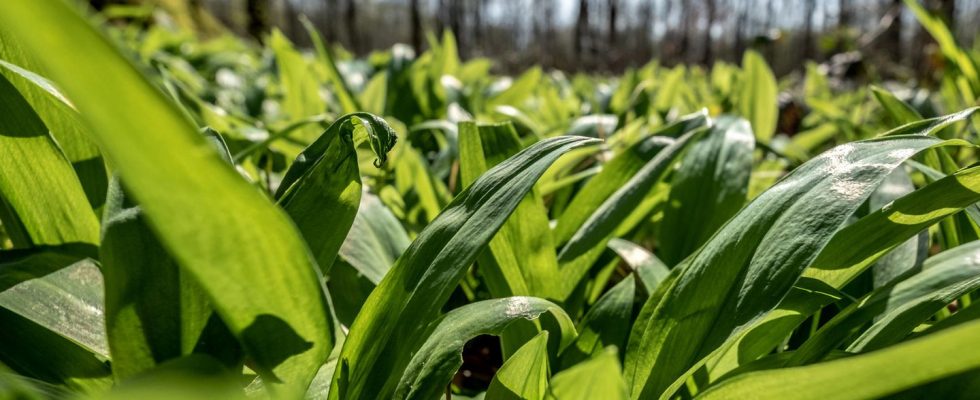Garlic of the forest
Harvest wild garlic now: How to recognize and pick the popular wild herb correctly
If you like garlic, you will love wild garlic. You can currently help yourself in many forests – but be careful: not everything that looks like wild garlic is actually edible.
© Oliver Hurst / Picture Alliance
In March and April, wild wild garlic reliably makes its big appearance. The popular herb covers large areas of shady parks and forest floors. And it exudes an intense, spicy garlic scent. However, caution is advised when picking for your own kitchen.
An intense and spicy scent hits the noses of walkers in many deciduous forests in March and April. Some people can’t get enough of it, others curse the penetrating garlic breeze. It’s wild garlic season. Like a huge carpet, the lush green wild herbs currently cover much of the ground in parks and riparian forests. And with them the smell of garlic is in the air. Fans of the spicy and aromatic tuber also love wild garlic. And help themselves along the side of the road in spring.
The star explains why wild garlic cannot be harvested everywhere, how to distinguish the real herb from the poisonous lilies of the valley and what else is important when picking.
Harvesting wild garlic: Where it is allowed and where it is not
Wild wild garlic feels most comfortable in shady and moist depressions in deciduous forests. There it sprouts lushly and often covers the forest floor extensively. In principle, wild garlic leaves and flowers can be collected for your own use in publicly accessible parks and forests and taken home. Nature reserves are an exception. There it is strictly forbidden to cut off parts of plants or tear out entire plants. Depending on the region, the wild garlic season begins in mid-March – and ends around the beginning of May when the herb blooms.
Important: Flowering wild garlic is not poisonous. But the otherwise juicy leaves become more fibrous as the flowers bloom and lose a lot of their taste.
Wild garlic versus lily of the valley: confusingly similar
At first glance, the leaves of wild garlic and lily of the valley look very similar. This is tricky because the inconspicuous lily of the valley is considered to be very poisonous. Neither the leaves, flowers or fruits should be consumed. But how do you know whether you are holding real wild garlic or poisonous lily of the valley leaves?
Three tips for safely identifying wild garlic
- Although the leaves hardly differ from each other in their oval shape, in contrast to lily of the valley, the underside of a wild garlic leaf is matt instead of shiny. In addition, the highlighted midrib is characteristic of the wild garlic leaf.
- The most striking difference between wild garlic and lily of the valley is the smell. To be on the safe side, rub a leaf from the collected plant between your fingers. An intense smell of garlic is a sure sign that you have wild garlic in your bag.
- If you still have doubts, you should look at the roots of the two plants. To do this, you carefully expose them. While lily of the valley develops horizontal roots, wild garlic develops from a bulb.
Harvesting wild garlic: the most important rules
Stocking up on wild, fresh wild garlic randomly and in large quantities in parks and forests in spring is not only inconsiderate. It also harms the population of the popular herb. In order to give the plants enough time to regenerate, a handful of tips should be followed when harvesting.
- Only cut off one or two leaves per plant (knife/scissors)
- Under no circumstances should you tear off the leaves
- only collect in large stocks
- Avoid trampling plants if possible
- Nature reserves are taboo for collecting
- Don’t collect more wild garlic than you really need
After the harvest: This is how wild garlic stays fresh for longer
When freshly picked, wild garlic does not last very long. The leaves wilt very quickly and should therefore be processed within a few days. To protect them from drying out, they can be wrapped in damp kitchen paper or a cloth shortly after picking – similar to asparagus. The leaves stay fresh for a day or two longer in the refrigerator. If you don’t like garlic in your house, you should keep the wild garlic in an airtight container, otherwise the distinctive smell will spread to other foods in the refrigerator. A book with tips and recipes is available here. Wild garlic leaves that are not processed immediately can be dried, soaked in olive oil, or frozen.
Tip: Wild garlic that has been freshly picked in the wild should also be washed thoroughly before eating it raw at home because of the fox tapeworm.
Sources: gardenjournal.net; utopia.de;
You might also be interested in:
This article contains so-called affiliate links. Further information are available here.


